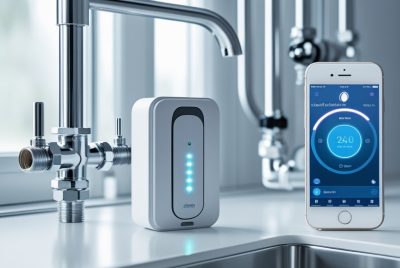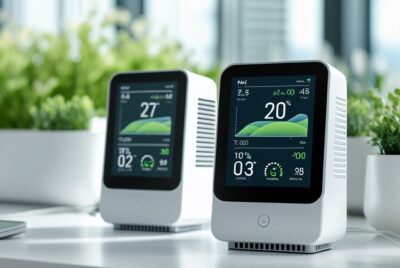Smart Home Systems: The Future at Your Fingertips
*We may earn a commission for purchases made using our links. Please see our disclosure to learn more.
Smart Home Systems: Enhancing Modern Living
Smart Home Systems are becoming an integral part of modern living. They use technology to automate and control various household functions like lighting, heating, and security. These systems aim to make life more convenient and efficient by integrating different devices and services that can be managed from a smartphone or tablet.
When looking to buy a Smart Home System, there are some important factors to consider. Compatibility with other devices in your home is key. Not all systems work well with every brand or type of device. Another crucial aspect is ease of installation and use. Some systems are plug-and-play, while others require more technical know-how. Security is also a top concern. It’s important to ensure that your system has strong encryption and security features to protect your personal data.
I tested several Smart Home Systems to find the best ones that can truly enhance the convenience and security of your home.
Top Smart Home Systems
I’ve researched and gathered the best smart home systems available today. These options will help you create a connected, convenient home.
Amazon Echo Hub
The Echo Hub is a solid choice for anyone looking to centralize control of their smart home devices with ease.
Pros
- Simple to install and customize
- Integrates well with many smart devices
- Offers multiple privacy controls
Cons
- Limited advanced features
- Difficult setup for non-tech-savvy users
- Additional accessories required for cable management
Setting up the Amazon Echo Hub was straightforward. I was able to mount it on the wall with relative ease, and once plugged in, it integrated with my existing smart home setup without a hitch. The ability to customize the dashboard to show only the controls and widgets I need makes managing my devices a breeze.
The integration with various smart devices was impressive. Whether it’s my smart plugs, cameras, or lights, everything worked seamlessly. Adding new devices through the Echo Hub was quick and painless, thanks to Alexa’s compatibility with many smart home protocols.
Privacy features on the Echo Hub are well-considered. I appreciated the multiple layers of privacy controls, including the microphone off button and the ability to manage my voice recordings. This gave me the reassurance I needed while using the device extensively in my home.
For more details, check out the Amazon Echo Hub.
Emporia Gen 3 Smart Home Energy Monitor
If you want a comprehensive energy monitoring system, then the Emporia Gen 3 Smart Home Energy Monitor is a solid choice for your home.
Pros
- Accurate and detailed energy monitoring
- Helps lower your electric bill
- Easy to install
Cons
- Needs 2.4 GHz WiFi
- App could use some improvements
- Requires additional sensor for some systems
I recently installed the Emporia Gen 3 in my home, and it made a huge difference in understanding my energy usage. The setup was surprisingly simple, attaching clamp-on sensors directly to my circuit panel. I was able to track real-time energy data straight from my phone.
This device is a game-changer for energy management. It helped me identify which appliances were consuming the most power, allowing me to adjust usage and save on my electrical bill. The system also gave me notifications about excessive energy use, which has been really useful.
While I liked the functionality, it does require a 2.4 GHz WiFi connection. Another thing I noticed is that the app could be more user-friendly. For homes with specific electrical setups, you’ll need to buy an additional sensor, which could be a bit of a hassle.
ULTIMEA 5.1 Surround Sound Bar
The ULTIMEA 5.1 Surround Sound Bar delivers an immersive audio experience ideal for both movie enthusiasts and casual TV viewers.
Pros
- High-quality surround sound
- Customizable bass levels
- Easy to set up
Cons
- Subwoofer and rear speakers are wired
- Design is simple
- Remote setup can be tricky
The ULTIMEA 5.1 Surround Sound Bar impressed me with its clear and distinct surround sound. The SurroundX technology genuinely makes you feel like you’re in the middle of the action. Adjusting the volume levels for the rear speakers using the remote was straightforward, letting me tailor the sound to my liking.
Switching between different sound modes, like movie or music, was seamless. The bass levels are deep and powerful, giving a real punch during action scenes. It does take some trial and error to find the best equalizer setting, but it’s worth it once you find the sweet spot.
Despite the ease of setup, the subwoofer and rear speakers are not wireless. Some may find this a bit limiting when arranging their home theater. Additionally, while the design is functional, it lacks the polish seen in higher-end systems. The remote can be tricky to master initially, but once familiar, it’s quite useful.
In summary, the ULTIMEA 5.1 offers an immersive sound experience that’s easy to set up and customize, although the wired components and basic design might be a drawback for some.
OSI Alarm System Gen 2
This smart home system is a solid choice for anyone wanting hassle-free, DIY home security.
Pros
- Simple setup with interactive wizard
- No monthly fees, ever
- Responsive touch screen and app integration
Cons
- Connectivity issues with 5GHz WiFi
- Sticky tape on sensors could be better
- Only two user accounts with full access
Setting up the OSI Alarm System Gen 2 was straightforward and quick thanks to the step-by-step wizard. The touch screen is responsive and doesn’t get smudgy, making it easy to use daily. Plus, the absence of monthly fees is a huge benefit.
I especially liked the scalability of the system. You can add up to 160 sensors, which makes it perfect if you have a larger home or even a small business. During testing, the sensors performed well, and I appreciated the dual batteries which ensured consistent performance.
However, I did encounter some challenges with the initial WiFi setup, particularly with the 5GHz band. Also, the adhesive on the sensors wasn’t the best, so you might need extra tape. Despite these hiccups, the system still delivered solid performance, making it a reliable choice for home security.
SimpliSafe 11 Piece Wireless Home Security System
This system is a solid choice for anyone looking for an affordable, easy-to-set-up home security solution.
Pros
- Effortless installation
- Real-time crime prevention
- Affordable monitoring
Cons
- Older software issues
- No glass break detection by default
- Limited range for some sensors
Setting up the SimpliSafe 11 Piece Wireless Home Security System was a breeze, with clear directions that anyone can follow. The system is ready to protect your home right out of the box, no need for wiring or drilling.
With its advanced AI and sensor technology, this system effectively detects real threats. I found the motion sensors to be quite accurate, alerting only when there was genuine activity and ignoring my pets. The live guard protection feature allows monitoring agents to intervene during an active alarm, which is reassuring.
One downside was the somewhat outdated software, although it didn’t affect the overall functionality much. The lack of a glass break detector by default means you might need to purchase additional sensors. Some sensors also have limited range, so positioning them correctly is crucial.
All in all, the SimpliSafe system provides excellent, comprehensive home security without long-term contracts or hidden fees.
REOLINK Smart 5MP Home Security Camera System
This smart home security system offers clear video quality and reliable performance day and night.
Pros
- Excellent 5MP HD video quality
- Smart detection for people and vehicles
- Easy plug-and-play installation
Cons
- Wired setup may be challenging for some
- Limited to 2TB HDD storage without external upgrade
- One-way audio only
I was impressed by the crystal-clear video quality of the REOLINK 5MP Home Security Camera System. Even at night, the advanced IR lights let me see everything up to 100 feet away. The cameras are robust and handle both indoor and outdoor conditions well.
One feature I found particularly useful is the smart detection for people and vehicles. This minimizes false alerts triggered by things like bugs or leaves, making it easier to monitor real threats. Setup was a breeze, even for someone who isn’t very tech-savvy. Just plug the cameras into the NVR, and it’s ready to go.
There are a few downsides, though. The wired setup might not be ideal for everyone, especially if you don’t have experience with such installations. The system comes with a 2TB HDD, which is great but could fill up quickly without adding an extra external HDD. Lastly, it has one-way audio, meaning you can’t speak through the device, only listen.
ecobee Smart Thermostat Premium
This product is a worthwhile investment for anyone looking to save on heating and cooling costs while maintaining optimal home comfort.
Pros
- Great energy savings
- Built-in air quality monitor
- Voice assistant compatibility
Cons
- Requires a subscription for some features
- Initial setup can be tricky
- Premium price
The ecobee Smart Thermostat Premium impressed me with its ability to optimize my home’s energy use. The device cut down my heating and cooling costs noticeably, making it a solid investment. The included SmartSensor works flawlessly to eliminate any hot or cold spots, providing an even temperature throughout my home.
I noticed the device’s built-in air quality monitor sends alerts when the air quality drops. This feature is handy for anyone looking to maintain a healthier living environment. It also gave me timely reminders to change my air filter, which keeps the HVAC system running efficiently.
While the thermostat works well, some functions require a subscription, which can be a bit disappointing. The initial setup was a bit challenging and might require professional help if you’re not tech-savvy. Nonetheless, once it’s up and running, the ecobee Premium truly adds value with its superior features and ease of use.
Controlling the thermostat using voice commands via Siri, Alexa, or Google Assistant adds a level of convenience that I found very useful. Despite its higher price tag, the advanced features and potential energy savings make it a smart choice for any modern home.
Buying Guide
Choosing the best smart home system can be challenging. Here are some key features to look for:
Compatibility
- Check if the system works with your existing devices.
- Ensure it supports various smart assistants like Alexa, Google Assistant, or Siri.
Connectivity
- Look for systems that use Wi-Fi, Bluetooth, or Zigbee.
- A strong network is essential for smooth functioning.
Security
- Ensure the system has strong encryption and security protocols.
- Look for features like two-factor authentication.
Ease of Use
- The system should be user-friendly with simple setup processes.
- Apps should be intuitive and easy to navigate.
Expandability
- Choose a system that allows adding new devices easily.
- Expansion capabilities are crucial for future-proofing.
Energy Efficiency
- Opt for systems with energy-saving features.
- Look for devices that can monitor and optimize energy use.
Customer Support
- Check the availability of customer support.
- Ensure there are plenty of resources like FAQs, manuals, and forums.
Frequently Asked Questions
I’ve gathered common questions about smart home systems. From improving home management to the costs and security involved, let’s go through the details.
1. How do smart home automation systems improve home management?
Smart home automation systems streamline daily tasks. They allow you to control lights, thermostats, and security systems from your phone or voice assistant. By automating these tasks, you save time and energy.
2. Which smart home system is considered the most user-friendly?
The most user-friendly smart home system is often thought to be Google Home. It has simple setup processes and intuitive controls. The Google Assistant also integrates smoothly with many devices.
3. What are the key differences between the top smart home platforms?
The key differences include compatibility, ease of use, and available features. Google Home is known for its simplicity. Amazon Alexa boasts a large number of compatible devices. Apple HomeKit is valued for its privacy features and seamless integration with iOS devices.
4. Can smart home systems be easily integrated with existing appliances?
Many smart home systems can be integrated with existing appliances. Compatibility depends on the appliance and the smart home system. Devices like smart plugs and bridges can help link older, non-smart devices to your network.
5. What is the average cost to upgrade to a fully automated smart home?
Upgrading to a fully automated smart home can vary greatly in cost. On average, you might spend anywhere from $1,000 to $5,000. This includes smart lights, thermostats, security systems, and other smart devices. High-end systems can cost even more.











